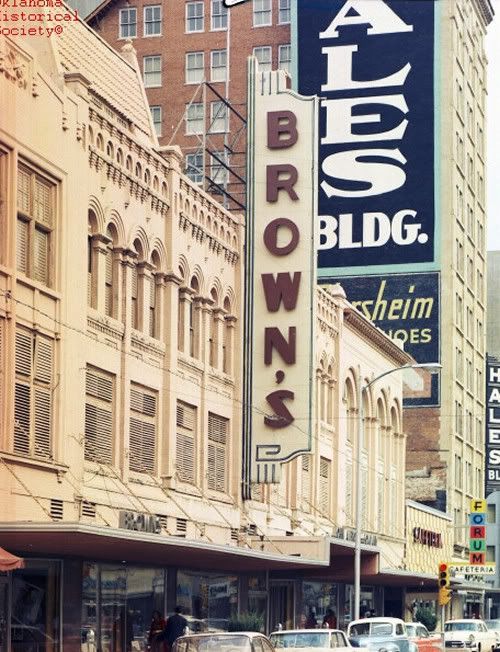
This article tells the story, at least a good part of it, of one of the most fondly remembered pieces of downtown-gone-by, John A. Brown's Department Store, located (by its end) in a large part of the square block between Robinson & Harvey and Park Avenue & Main. The story spans time from the early 1900's until the family business was eventually acquired by Dillard's in 1984, shortly after which "John A. Brown's" as a department store name was known no more. To jump to pieces of the story, click a link below:
| Pre-Brown's History | Brown's Alone | Civil Rights Era |
| Exiting Downtown | Other Brown's Stores | End of the Era |
 BEFORE BROWN'S. Brown's origins pre-date John A. Brown's -- they go back to at least 1901. Tracing backward to the earliest years in an attempt to identify the oldest "property" which would come to be associated with the family's name, the first name identified in the Oklahoman's archives was the Mitscher-Mitchell Dry Goods store. The brief December 20, 1901, article merely mentions that holiday business was good but says little more. At the time, the dry goods store was located on the south side of the 200 block on West Main. By February 1904, the company had done well and expanded to a larger building on the north side of Main to two addresses, 213-215 W. Main, the beginning pieces of John A. Brown's. This February 3, 1904, Oklahoman article doesn't particularly identify the initial addresses but they were 213-215 W. Main, immediately east of S.H. Kress which was immediately east of the Illinois Hotel.
BEFORE BROWN'S. Brown's origins pre-date John A. Brown's -- they go back to at least 1901. Tracing backward to the earliest years in an attempt to identify the oldest "property" which would come to be associated with the family's name, the first name identified in the Oklahoman's archives was the Mitscher-Mitchell Dry Goods store. The brief December 20, 1901, article merely mentions that holiday business was good but says little more. At the time, the dry goods store was located on the south side of the 200 block on West Main. By February 1904, the company had done well and expanded to a larger building on the north side of Main to two addresses, 213-215 W. Main, the beginning pieces of John A. Brown's. This February 3, 1904, Oklahoman article doesn't particularly identify the initial addresses but they were 213-215 W. Main, immediately east of S.H. Kress which was immediately east of the Illinois Hotel.Soo... what would one actually buy at a "dry goods store?" On January 21, 1904, it was stuff like this ...
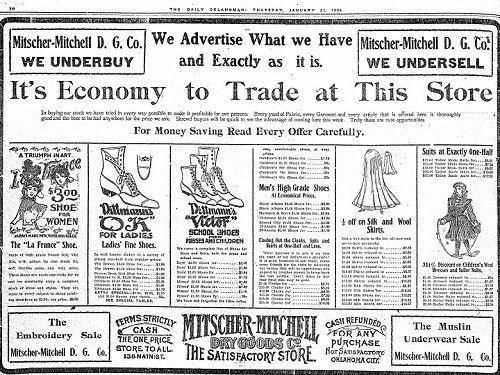
The March 5, 1904, Oklahoman story shown below announced a new tenant in the West Main property, Sidney L. Brock -- he didn't purchase the existing business, he started his own, but in the same shop:
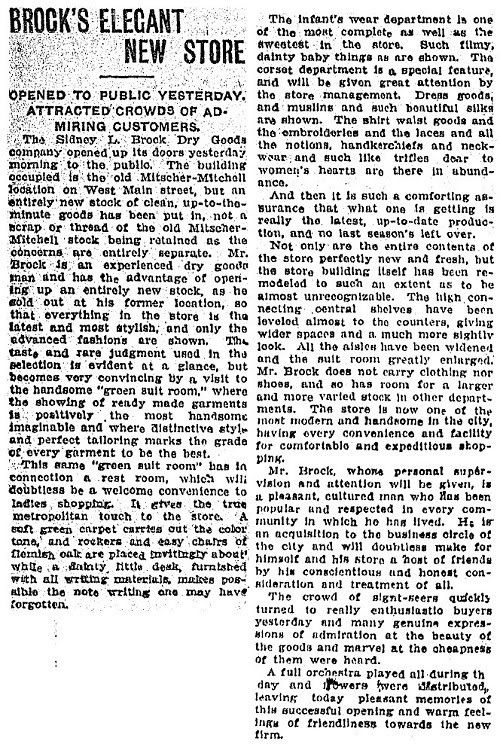
The taste and rare judgment used in the selection [of goods] is evident at a glance, but becomes very convincing by a visit to the handsome "green suit room," where the showing of ready made garments is positively the most handsome imaginable and where distinctive style and perfect tailoring marks the grade of every garment to be the best. ¶ This same "green suit room" has in connection a rest room, which will doubtless be a welcome convenience to lades shopping. It gives the true metropolitan touch to the store. [Emphasis supplied]MEN might have thought such a convenience to have been "metropolitan," as well!
Oklahoman ads, like the June 18, 1905, cropped ad below, show the address:

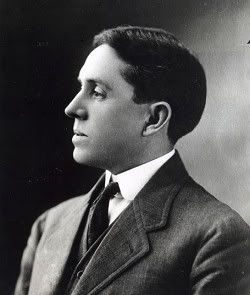 Brock's Dry Goods did very well. Sidney Brock was apparently a young fellow -- the picture shown here was taken in 1915 (credit OHS). A 1910 Oklahoman article said that more than 60 of Brock's clerks attended an employee appreciation event at the Metropolitan Theater.
Brock's Dry Goods did very well. Sidney Brock was apparently a young fellow -- the picture shown here was taken in 1915 (credit OHS). A 1910 Oklahoman article said that more than 60 of Brock's clerks attended an employee appreciation event at the Metropolitan Theater.Brock's was then located at 213-215 W. Main. In 1904, and abutting Brock's on the west at 217 W. Main, S.H. Kress 5¢ and 10¢ store was constructed and the Illinois Hotel (to become Hotel Kross in 1905) was at 219 W. Main. Kress expanded before 1911 to use the 1st floor of Hotel Kross (by then called "Hotel Parkinson" but by then it was only a walk-up rooming house.)
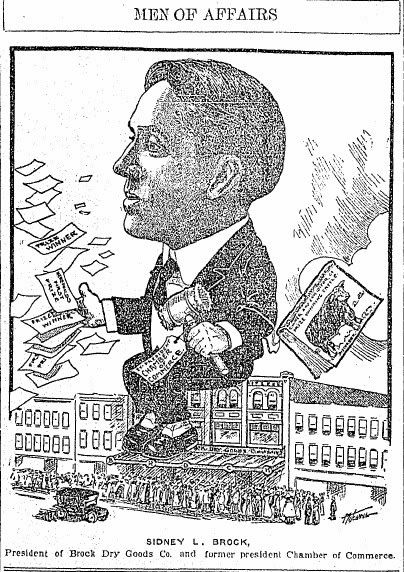
Kress & Co. did move, and when Brock remodeled the Kress properties during July-September 1914, Brock Dry Goods Co. doubled in size. I've wondered for a long time what became of the Illinois Hotel, when it was destroyed, etc., and the August 23, 1914, ad below shows what happened -- it was never destroyed, it was simply absorbed into the Brock's Dry Goods business. Notice the angular roof on top of the former Illinois hotel under which is a room -- this roof will be recognizable in many of the later photos of Brown's Main Street side. Masons cut archways to span the Kress properties to match the arches on the Brock's original property at 213-215 W. Main. Compare the crop of the Vanished Splendor II postcard with the Oklahoman advertisement shown below:
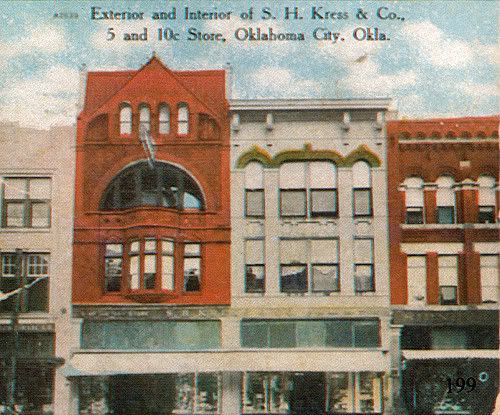
August 23, 1914, Oklahoman ad
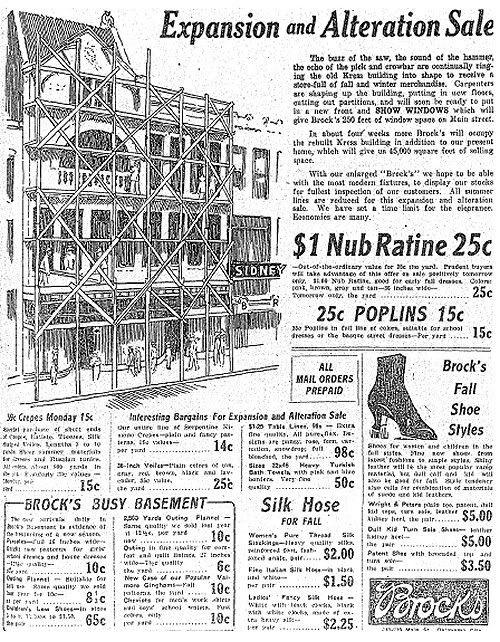
Rorabaugh-Brown Dry Goods. In 1915, however, Brocks Dry Goods came to an agreeable end -- the front page of the August 6, 1915, Oklahoman reported that the business had been acquired by a Kansas company, the Rorabaugh Company, which operated successful business in Wichita, Hutchison, and Emporia, as well as at Guthrie and Decatur, Illinois. The Guthrie business was known as "Brown Dry Goods." The Oklahoma City business remained "Brocks" for a short time, however with post-sale 1915 ads like the cropped October 9 ad below, a familiar name at last appears -- "JNO. A. BROWN, V. Pres."

By March 1916, the business became known as the "Rorabaugh-Brown Dry Goods Co.," as shown by the Oklahoman ads below:
March 19, 1916
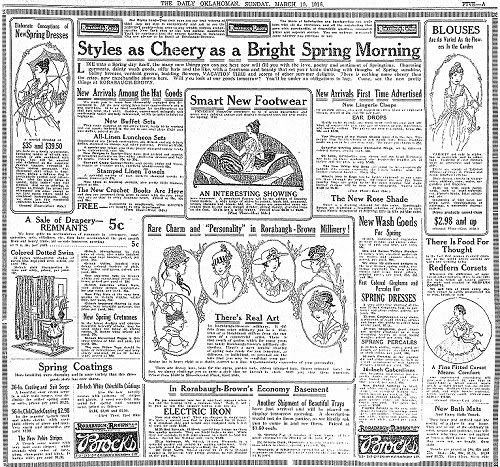
December 14, 1916
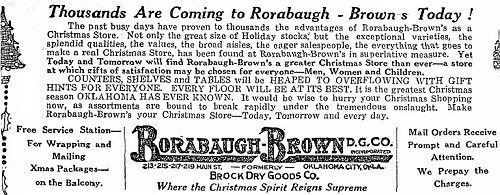
As of the December 16, 1923, Oklahoman advertisement, cropped below, Rorabaugh-Brown's did not extend west of the Illinois Hotel site nor east of its original location:
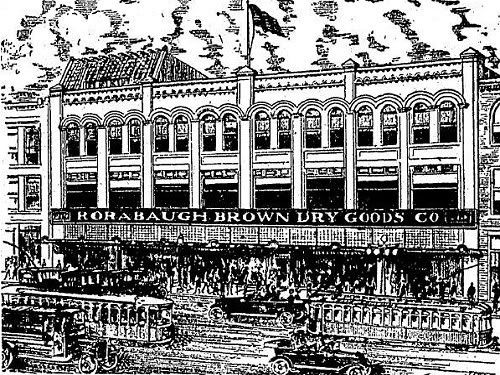
221 W. Main (slighly shown at the left side of the the above drawing) came under the Rorabaugh-Brown umbrella in February 1925. From 1906 until that time, the property was the home of the Frederickson-Kohl Music Company which built a new facility in 1924. Its last "sale" at the 221 W. Main location is shown by an Oklahoman ad to have been January 31, 1925, and Rorabaugh-Brown's expanded to include it shortly thereafter.
In the undated OHS image shown below, Rorabaugh-Brown's awning extends to the right of the signage (under the windows with wider arches) -- that property is 211 W. Main. See more discussion about this under "Brown's Alone," below. My guess is that this photo was taken between 1925-1927 or so.
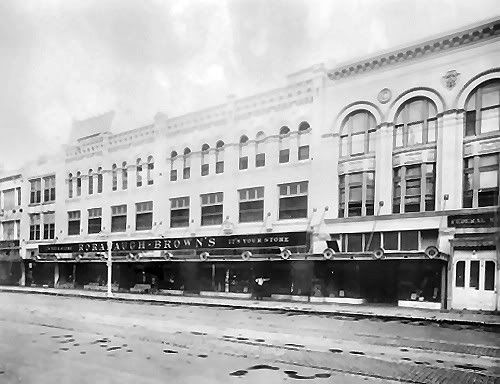
Compare the above with this undated (but probably in the late 40s or early 50s -- notice the trolley tracks still present) OHS photo of "Brown's" showing that expansion to include 209-211 W. Main, below (click the image for a slightly larger view):
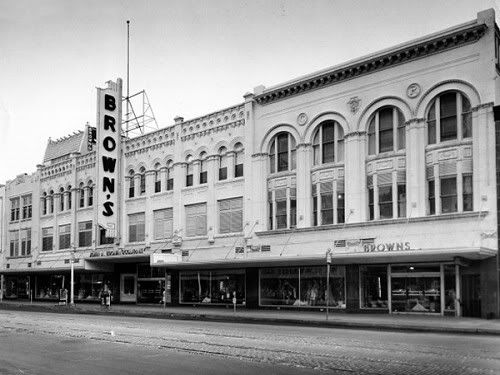
As is also discussed in "Brown's Only," below, the company began expanding to West 1st (Park Avenue) in 1922 or 1923 when it began occupying the property immediately west of the Perrine/Cravens/Robinson Renaissance Building, 210-212 W. 1st Street. Photographs of that building are in "Brown's Only," below. Although I could not locate an Oklahoman reference which described any "transaction" concerning this tract, ads do show that (1) as of July 2, 1922, the tract was occupied by Byers Dry Goods Co. (and before that Walker-Taylor Co., printers and stationers), and (2) by November 15, 1923, Oklahoman ads identified the address with Rorabaugh-Brown's toy and flowers departments.
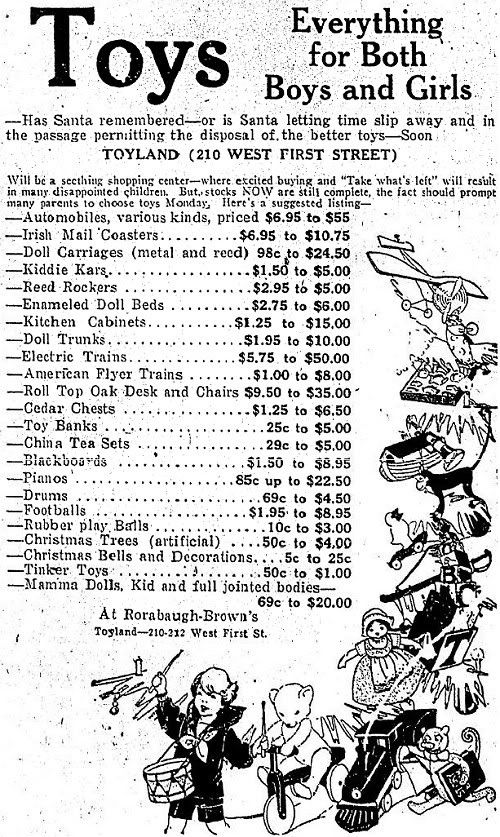
March 9, 1924
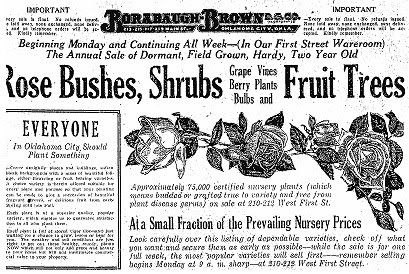
A nice OHS photo shows Rorabaugh-Brown's delivery trucks in 1925, below:
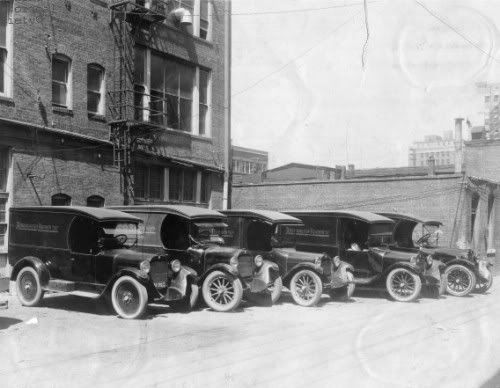
It's kinda fun looking at some of the old ads, particularly those showing pretty ladies in high heels wearing swimming suits -- or is that just me -- You can swim can't you? -- I can sure as heck try!
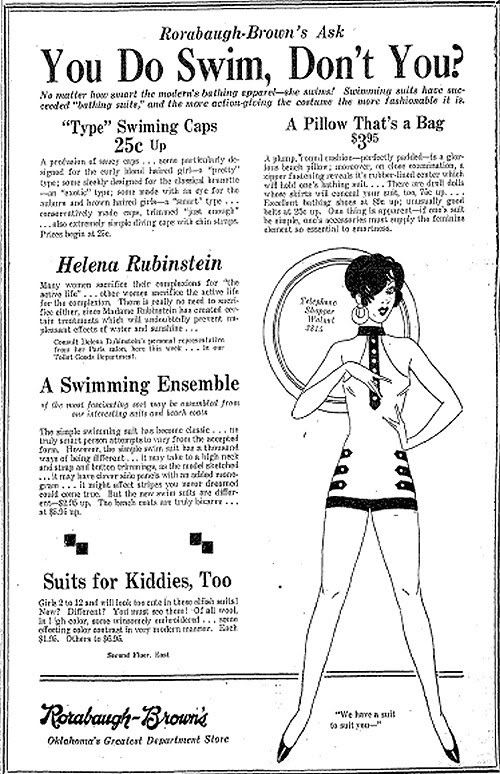
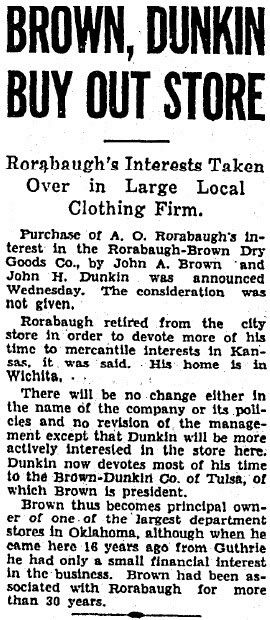 BROWN'S ALONE. The pre-Brown's era came to a close in February 1932. The small Oklahoman February 4, 1932, article at the right gave some of the detail -- A.O. Rorabaugh's interest was then acquired by John A. Brown and John H. Dunkin, and the Oklahoma City store then truly became Brown's, "John A. Brown's Department Store," to be more particular.
BROWN'S ALONE. The pre-Brown's era came to a close in February 1932. The small Oklahoman February 4, 1932, article at the right gave some of the detail -- A.O. Rorabaugh's interest was then acquired by John A. Brown and John H. Dunkin, and the Oklahoma City store then truly became Brown's, "John A. Brown's Department Store," to be more particular.This is a good place to give more detail about family relationships. Recall from above that the Rorabaugh interest included a store in Guthrie, "Brown Dry Goods." John A. Brown was a cousin of Kansan O.A. Rorabaugh. John's wife, Della Dunkin Brown, was a sister to John H. Duncan. The Brown-Duncan family came to own and operate the state's finest department stores (see Other Brown's Stores, below).
Born near Canton, Ohio, in 1878, in 1900 John moved to Emporia, Kansas, where his cousin, O.A. Rorabaugh, had a small mercantile business, and John began working there as a window trimmer. In Kansas, he got a year of college at Baldwin's Baker University and then returned to Emporia to work in the Rorabaugh store until 1907.
A Few Other Words About the Browns. A bit about John A. Brown's history is stated above including that, while in Guthrie, he married Della Duncan. According to an April 25, 1967, Oklahoman article, although living in Guthrie when marrying John, Della's roots were in New Mexico, being born in Las Vegas, N.M., the daughter of John McFarlin and Ida A. Duncan. The article does not detail her family's arrival in Guthrie, or Oklahoma.
After the Browns moved to Oklahoma City, they had two principal elegant residences: 301 N.W. 18th in Heritage Hills, and then 1601 Guilford Lane, Nichols Hills, shown in the County Assessor photos below:
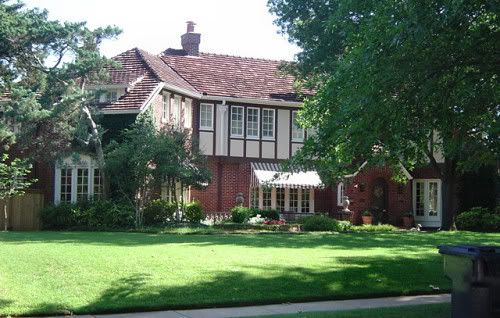
1601 Guilford Lane, Nichols Hills
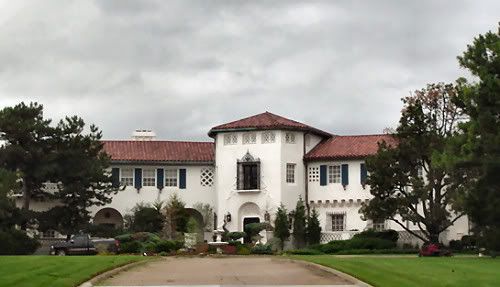
John A. Brown was inducted into the Oklahoma Hall of Fame in 1933; Della Dunkin Brown was also, in 1959.
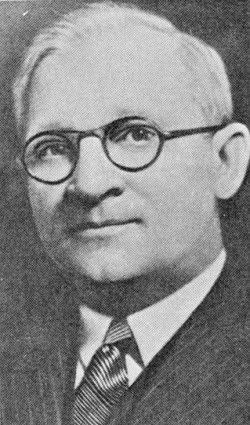 John A. Brown | 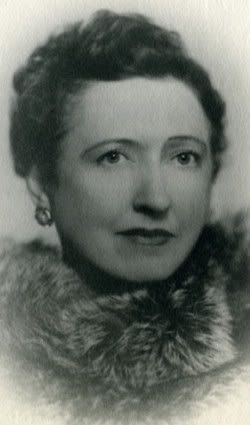 Della Dunkin Brown |
A glimpse into the Browns' private life occurred shortly after Della's death in 1967. In an April 30, 1967, Oklahoman article by J. Willis Baker, it is reported that the Browns may have lived in a state of fear, fear of kidnapping, fear of physical harm. You can read the article and judge for yourself.
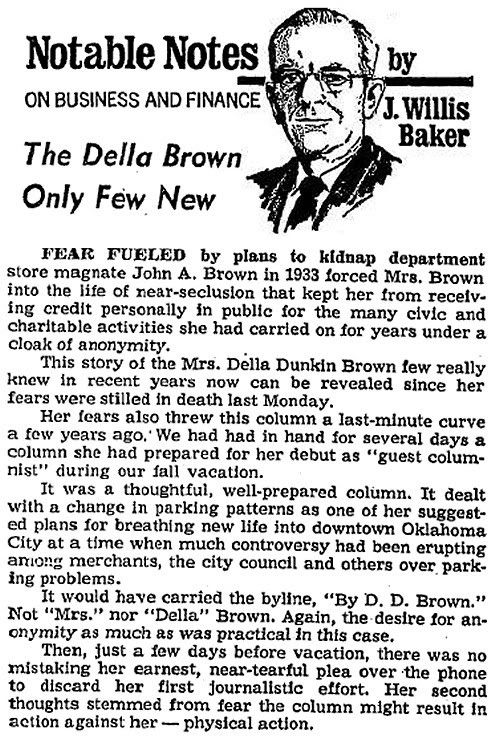
Expansion. After Rorabaugh's interest was acquired by John A. Brown and John A. Duncan in 1932, the John A. Brown Company entered into its greatest period of expansion, including additional properties on Main Street and on West 1st Street (Park Avenue).
- On Main. Two separate addresses were added (221 W. Main on the west was acquired around 1925 under the Rorabaugh-Brown's era but I'll add some additional comments), 209 and 211 W. Main on the east, described below.
- 221 W. Main. As described in "Before Brown's," above, this address became occupied by Rorabaugh-Brown in February, 1925. From 1906 until that time, the property was the home of the Frederickson-Kohl Music Company which built a new facility in 1924. Its last "sale" at the 221 W. Main location is shown by an Oklahoman ad to have been January 31, 1925.
- 211 W. Main. The property was occupied by Armstrong-Byrd Music Co. (or M.B. Armstrong Music Co.) from around 1908 until February 1927; the Piano Exchange acquired the stock of M.B. Armstrong Music Co. and operated at the address from December 7, 1926, until May 1927, at which time it relocated to 131 W. Main; no tenant after May 1927 as an occupant of that address; my best guess: the address was occupied by Rorabaugh-Brown's on or shortly after May 1927
- 209 W. Main: At least until July 29, 1933, it was occupied by other tenants, then Federal Savings & Loan Association of Oklahoma (circa 1930-1933); before that, Wilkin-Hale State Bank (1921) which bellied up in 1923; Oklahoma National Bank (1924) which moved when it merged with Liberty National Bank in 1926; other tenants included the Booterie Outlet which operated out of the basement at least between 1923-1926; no ads for the address appear between July 29, 1933, and 1956, when the address shows up in a Brown's ad; my best guess: the address was occupied by John A. Brown Co. circa 1933-1934
but 209 W. Main does not

Click on the images below for a slightly larger view
After becoming "Brown's"

Below: at left, 221 W. Main; in center, 213-219 W. Main;
at right, 211 W. Main and then 209 W. Main (larger arches)
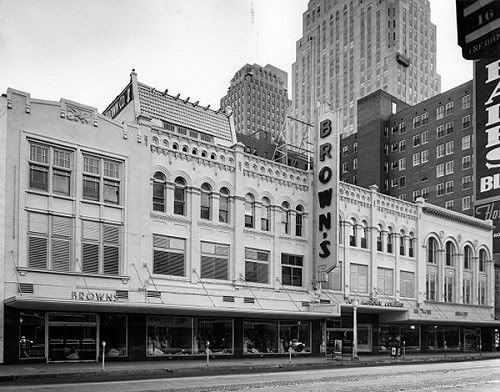
- On 1st Street/Park Avenue. Four separate transactions must have occurred for Brown's expansion to Park Avenue: (1) 210-212 W. 1st, already discussed in "Before Brown's"; (2) 214-216 W. 1st; (3) 218-224 W. 1st; and (4) 226-232 W. 1st.

In figuring this out, it helps to compare the 1922 Sanborn Map and its 1955 revision -- click on maps for larger views:
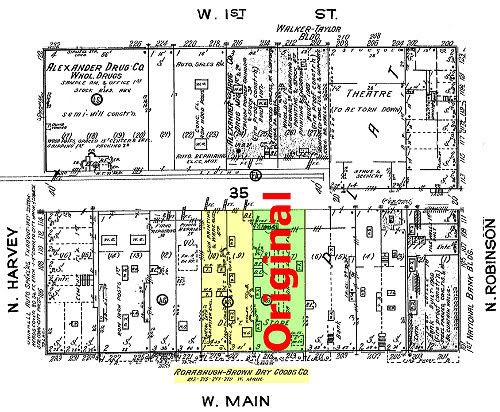
1955 revision showing all Brown's addresses

| As previously discussed, the 5-story 210-212 property immediately west of the Perrine/Cravens Building was acquired in 1922 or 1923. This February 27, 1937, article describes the 3-story property to the west of 210-212, 214-216 W. 1st Street owned by the Alexander Drug Company. As will be shown in photos below, the Alexander Drug Company had extensive holdings on the south side of the 200 block of W. 1st Street (Park Avenue) block prior to Brown's acquisition of any interests in that block. This tract is #2 (yellow) in the marked-up photo shown above and is also seen in the detail of the 1922 Sanborn map. Thus far, I've not found anything which definitively identifies when Brown's acquired the 218-220-222-224 West 1st Street addresses (other than, as shown below, it had occurred by the 1950-52 expansion), all addresses being parts of the same 5-story building. Various retailers occupied particular addresses in that address-span, the most recent that I could find being the Oklahoma China Shop at 220 W. 1st as late as December 1948. But, see the next paragraph for a bit more. | 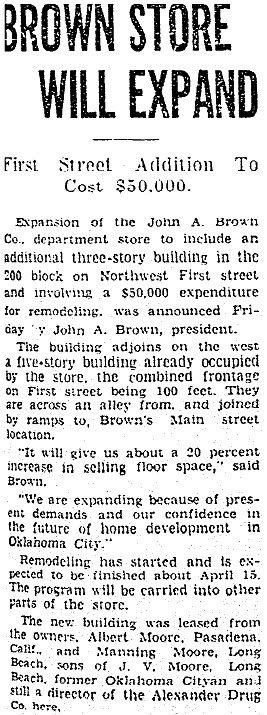 |
The addition will add about 105,000 square feet to Brown's downtown floor space, an increase of 36 percent in the store's size. With the Alexander building, Brown's will occupy the south side of NW 1 from Robinson to Harvey, a full block.So, apparently, the "missing transaction" as to 218-224 W. 1st Street had already occurred. The September 4, 1952, Oklahoman reported that the acquisition of that property quadrupled its "basement" shops from 14,000 square feet to 48,000. The article also noted that the connections, above and below ground, between the Main Street and NW 1st Street properties were first made in 1928 but were expanded in 1951.
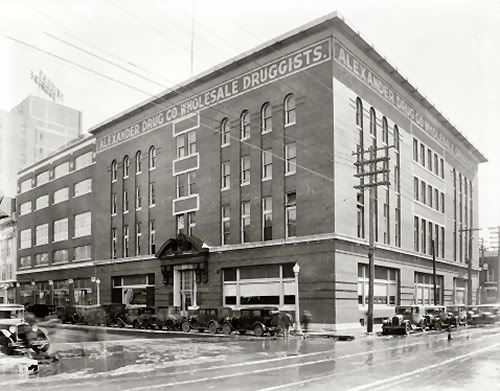
In 1946, looking more easterly toward 1st National
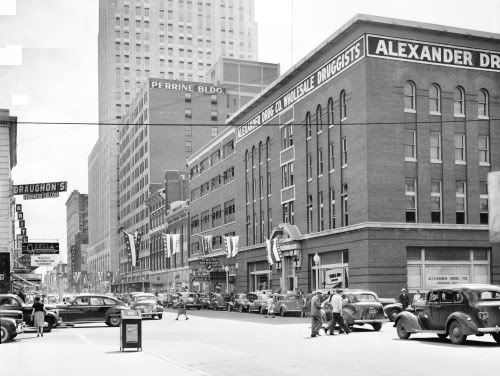
In 1946, looking southeasterly along Harvey
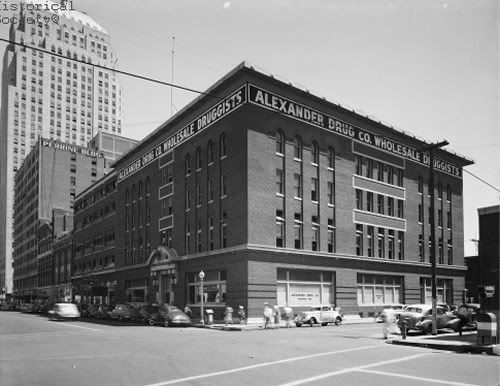
In 1946, looking east along alley toward 1st National
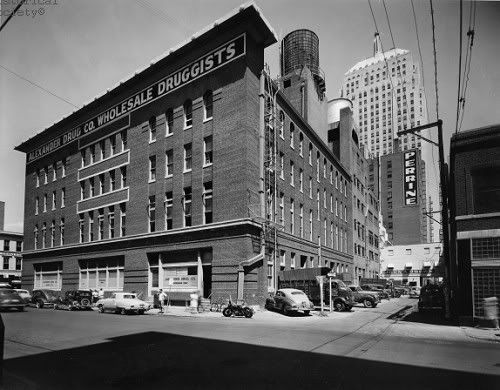
As Brown's in the 1950s -- click pic for slightly larger view
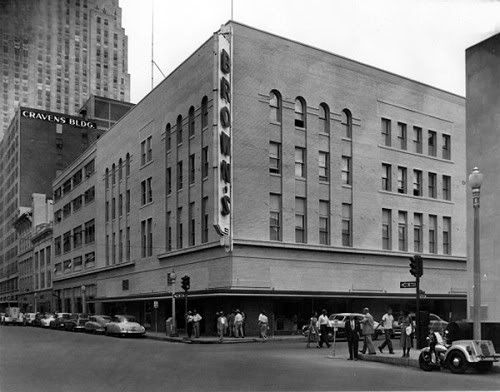
As Brown's in the 1960s, looking southeast along Harvey
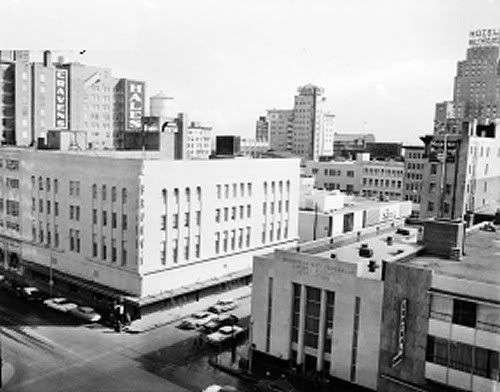
Brown's immediately west of Perrine/Cravens Building
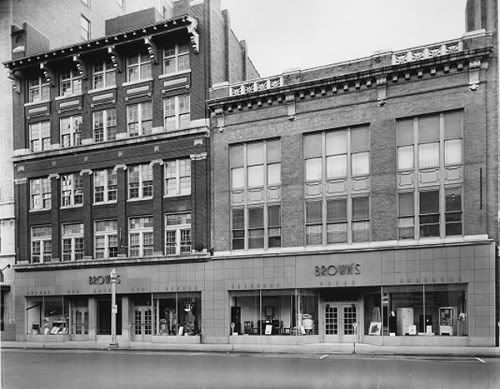
Brown's looking east along W. 1st Street
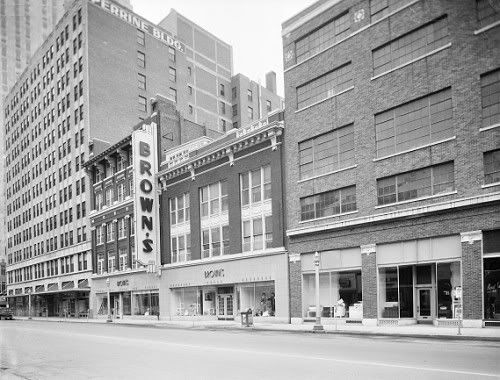
A Last Look At Downtown Brown's. Unless otherwise identified, the following are nostalgic images of downtown Brown's at the OHS website. Have a look . . .

May 21, 1949, parade celebrating Judy the Elephant
Kids contributed their coins and collected money from others for the Oklahoma Zoo to purchase an elephant, and Judy, as a baby elephant was the result. She was transported to Oklahoma City in bad weather but the clouds broke and she arrived on time for her grand parade along Main Street. The photo angle prevents you from seeing her, but she was riding on the back of the "Riss Special" truck. Judy was a favorite from 1949 until she died in 1997 and manhole covers at the zoo remember her to this day (see below). The following image (and its cropped views) show Judy's 1949 parade and are from Amy Dee Stephen's The Oklahoma City Zoo, 1902-1959 (Arcadia Publishing 2006). Click the images for larger views.
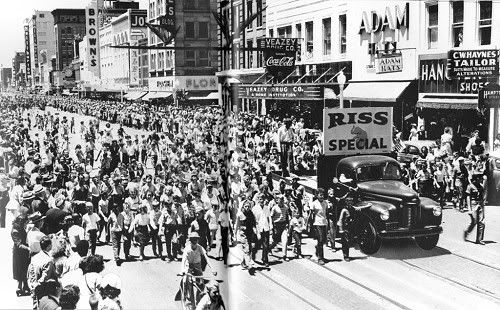
A crop showing Main from east of Robinson
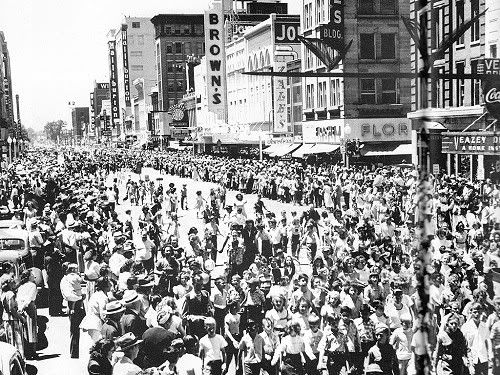
Another crop focusing in on Brown's
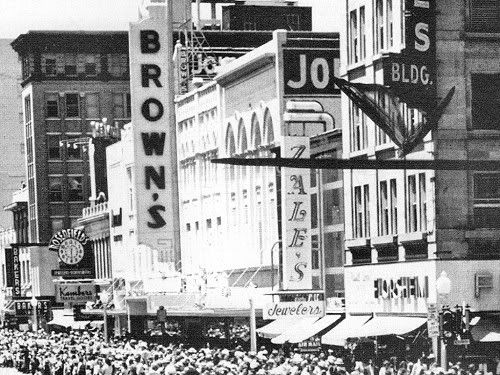
Judy as a baby at the OKC Zoo & Manhole Covers Today
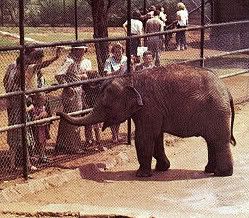 | 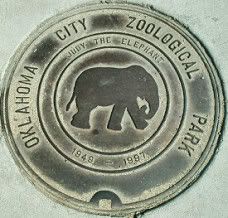 |
1940s street car from Vintage Rail Photos
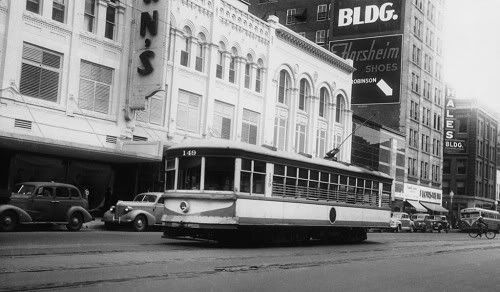
Inside in 1960, from Metropolitan Library System
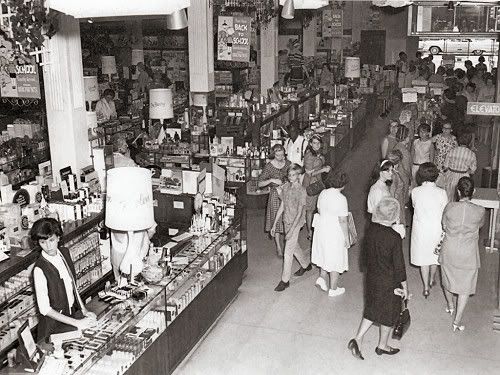
According to an August 10, 1984, Oklahoman article, "Brown's Main Street windows were a child's paradise at Christmas, decked out in electronic, animated creatures and Santa Clauses. For 45 years or longer, the changing window scenes became a seasonal 'must' for the young."
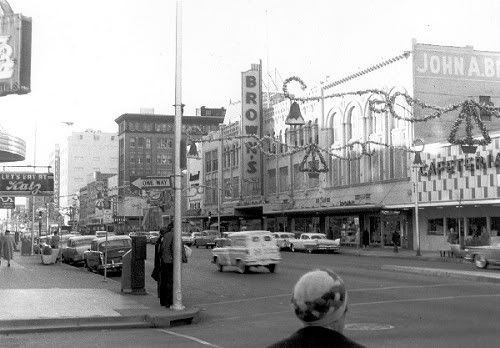
Christmas At Night, 1946
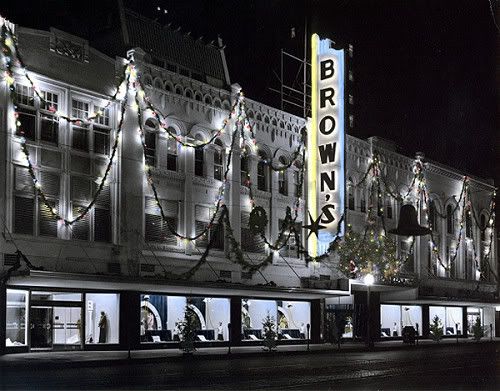
In the 1940s
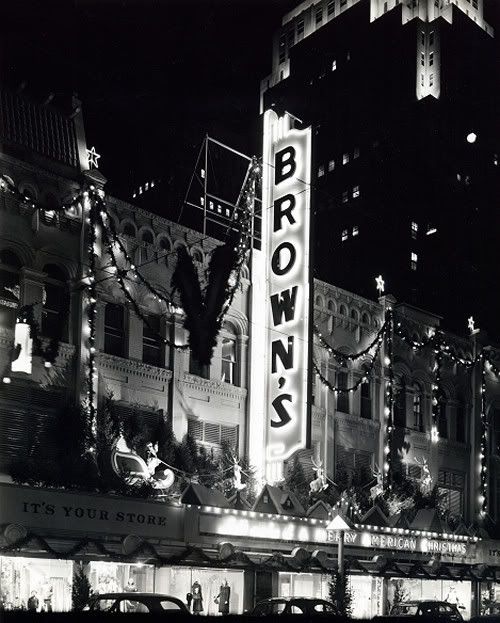
In 1947

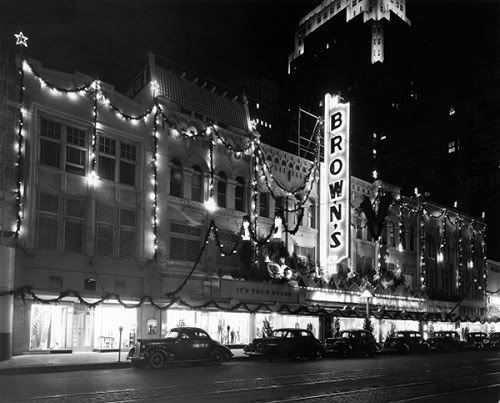
CIVIL RIGHTS ERA. Downtown Civil Rights sit-ins began in earnest in 1958 and they included John A. Brown's. As noted in this this Harding University (Arkansas) PDF file,
A portion of the group moved on to John A. Brown’s, the largest department store in Oklahoma, covering a block and a half of downtown. It was at Brown’s they faced the longest, most difficult battle. The sit-in at Brown’s began August 22, 1958, and continued without cessation until June 23, 1961. It was the longest single sit-in campaign of the country by 1961 ("Nation’s Longest"). The sit-in was resolved after Brown’s agreed to end bias in the lunchroom, soda fountains, and rest rooms throughout the store.See the full PDF file for more.
* * *
The abuse and hate calls from the white community were more violent and disturbing. During the sit-in at Brown's, shotgun shells were left on [Clara] Luper's porch with a Ku Klux Klan note, and someone broke into her home and burned some furniture (Luper 20-21). At one point the police met her at Brown's to warn her of a bomb threat against her home. Luper rushed home to get the flag that had covered the casket of her father, a World War I veteran. News of the bomb threat was spread by radio. Friends came to watch her house so that she could return to the demonstration. Members of the American Legion and the Veterans of Foreign Wars offered their support to prevent bombings and violence in Oklahoma City. A white woman Luper had never met offered to keep the flag in her safety deposit box (Luper 20-22).
A few brave white people came forward to help the Youth Council win their war against segregation. Some wrote letters to the management of Brown's declaring their support for the NAACP youth. On September 13, 1960, Howard Furlow wrote Mrs. John A. Brown, the owner of Brown's, to inform her that his family would no longer shop at her store. He even mentioned the furniture he had intended to purchase and the stores he had chosen instead of Brown’s (Furlow). An anonymous letter to the editor of the Black Dispatch also voiced support for the sit-in movement at Brown's. The author claimed to be a patron of Brown's who planned to withdraw support because of the sit-ins. This person went so far as to say, "There is no place in enlightened Oklahoma City for your business unless your policy changes (Black Dispatch 29 August 1958). As an act of kindness and support, an elderly white man ordered ten dishes of ice cream for the young people at Brown's. The demonstrators declined the ice cream, one of them saying, "He's very nice, but I don't think wed better."
I thank John Proctor of Oklahoma City for furnishing still shots from a 1984 television video in what appears to be John A. Brown's in 1958 or 1959. I've reassembled the shots into a small flash file.
OHS's internet archives contain various sit-in photos at Brown's, some shown below.
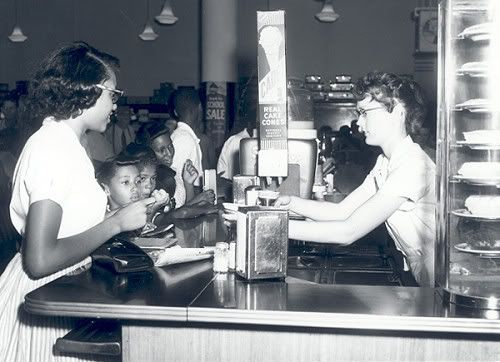
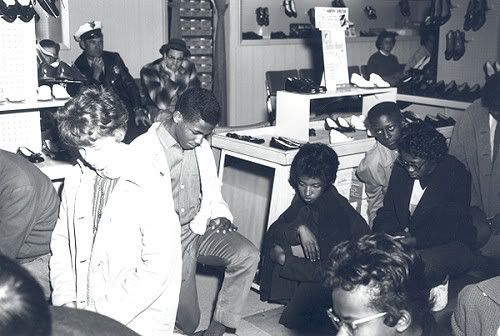
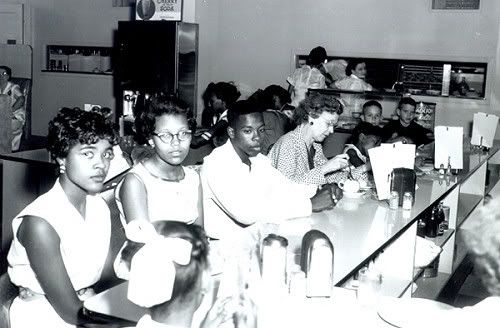
EXITING DOWNTOWN, STEP BY STEP. Throughout the lifetimes of John A. Brown and Della Dunkin Brown, the John A. Brown & Co. Department Store easily became the preeminent department store in Oklahoma City and probably all of Oklahoma. It truly was a "destination," not only for shoppers in Oklahoma City but throughout the state. With its hodgepodge of eclectic buildings, many of which were connected with sloping carpeted planes where an adjoining building's height did not exactly match, and goods offered for sale being personally selected by Brown's (principally including but not limited to Della Brown), it was a shopper's paradise. At least by the 1950s, payments made to a salesperson were stuck into one of the many pneumatic tubes which whisked the payment and sales slip to some unknown destination (doubtless a central clerical area) -- the receipt would be returned in the same way.
It could not be imagined that this assortment of buildings with all of its departments could possibly be located anywhere else than it had been with roots dating back to the original 1904 Mitscher-Mitchell Dry Goods store, then Brock's, then Rorabaugh-Brown's, and last John A. Brown's. It was not merely an Oklahoma City store, it was regional and historical in its scope. Everyone knew of it, had shopped its passageways, and knew where it was and where it belonged to be, in the heart of downtown Oklahoma City.
But, could the unimaginable happen, could Brown's actually leave downtown?
Not during the lifetime's of John A. Brown and Della Duncan Brown, that's for sure. While on a trip with his wife, John A. Brown died unexpectedly from heart failure on January 25, 1940, in Rochester, Minnesota. A January 26, 1940, Oklahoman article which reflected on his life told a bit of his life story. In addition to tracing his history with the business, it noted that a few years before his death his then 530 employees honored him with a memorial dinner and presented him with a testimonial signed by all which called him, "honest, sound from center to circumference, true to the heart's core." Although active with the family business, as well as multiple civic, business, and personal endeavors, when commenting upon his being selected as "Oklahoma City's most useful citizen" in 1930, he simply replied, "I'm not so hot."
After his death, Della (who by all reports was always very active in the business) assumed the management of the store, a role which she retained until her own death in 1967. It was during Della's tenure that many of the West 1st Street (Park Avenue) expansions took place.
Penn Square. Also during her tenure, Brown's began to look elsewhere for at least a part of its future. Plans were announced for what would become Penn Square Mall in 1955 -- then expected to be called, "Belleview Shopping Center" -- and Brown's, along with Montgomery Wards, were to be the center's initial anchor tenants. Brown's announcement was reported in the August 5, 1958, Oklahoman:

Nonetheless, Mrs. Brown remained steadfast about maintaining the John A. Brown's presence in downtown. The OHS photograph below shows Mrs. Brown at a luncheon attended by Mayor James H. Norick (according to OHS photograph notes). The on-line version of this photograph is not dated but IF the OHS note is correct (that is, that Norick was then "Mayor" Norick -- and since he took office as mayor on April 11, 1967), this photograph would have been taken just days before her April 24, 1967, death.
Anita Colby; Mayor James H. Norick (father of Ron Norick)
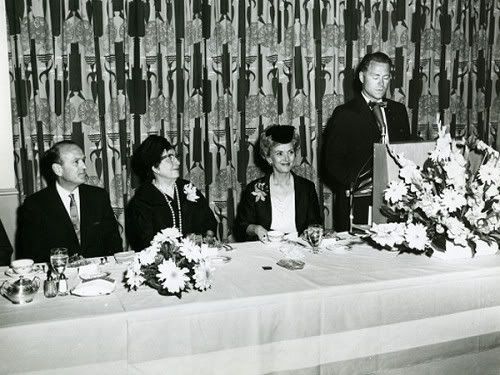
The following remarks were attributed to her in an August 10, 1984, Oklahoman article (the day of the report that Dayton Hudson was acquired by Dillards, "End of An Era," below).
Today, newly sold to Dillard Department Stores, Inc., Brown's future is unclear. But as long as there is a former customer of the Main Street store, it will have a past.A few months after those remarks, she died at 84 years of age. An April 25, 1967, Oklahoman article reported that,
* * *
Mrs. Brown was faithful to downtown as well. When rumors of a closing spread in 1966, she vehemently denied them. ¶ "The store is not for sale," she declared, disclosing plans were under way for the "nicest store in the Southwest, if, and when, urban renewal authorities decide to leave me alone." ¶ Just back from New York, she said, "I'm staying. . . . While others have, I'm not running out on downtown, because no one, my people or my customers, have ever run out on me."
With 1,300 employees, the company ranked as the eighth largest employer in Oklahoma City in a January survey.The 1984 article said, "Her will placed control of the stores in the hands of two long-time employees, the company lawyer and tax accountant," and it would be up to them to determine Brown's downtown future.
Dayton Hudson. But, not for long. The Oklahman's January 21, 1971, page one headline appears below.

The story announced that the John A. Brown Company had been sold to Dayton Hudson Corp., a Minneapolis retailer, and that the downtown, Penn Square, Capitol Hill, Tire Store (NW 39th & Penn), and Norman locations were all included. Part of the article said,
Stanton L. Young, former president of the Oklahoma City Chamber of Commerce, said that purchase of the company by Dayton Hudson provides a needed chapter in the success story of the city's downtown redevelopment. "When you redevelop a business district, you need a cornerstone, a major commitment," he said. "This is that commitment." He said that the purchase will be regarded as a vote of confidence in the future of downtown Oklahoma City.Under the arrangement, the article said that Brown's would be an "independent operating unit" and that the name "John A. Brown's" would continue to be used. The article said that the firm would look for new locations in areas "like Penn Square" and that possible downtown locations, whether in or out of the Urban Renewal galleria project, were up for grabs.
Crossroads and Quail Springs. Under Dayton Hudson's ownership, Brown's expanded to Crossroads Mall at the intersection of Interstates 35 and 240 in the south part of town. The Mall opened on February 17, 1974 with Governor David Hall cutting the ribbon, and the new Brown's store opened in August.
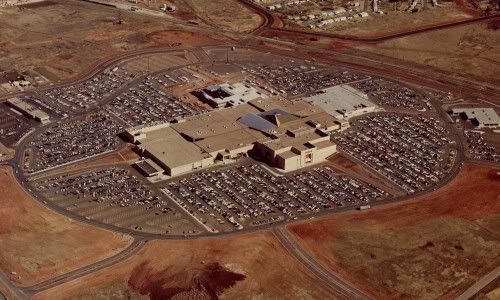
Coinciding with this event was the closing of the downtown and Capitol Hill Brown's stores. A February 1, 1974, Oklahoman article reported that Dayton Hudson was hopeful that a return to downtown would occur when the pieces for the proposed Galleria fell into place -- which, of course, they never did. The same article reported that Dayton Hudson was looking further ahead to include a Brown's in the then proposed Quail Springs Mall in far northwest Oklahoma City.
Courtesy OKC: 2nd Time Around by Steve Lackmeyer & Jack Money
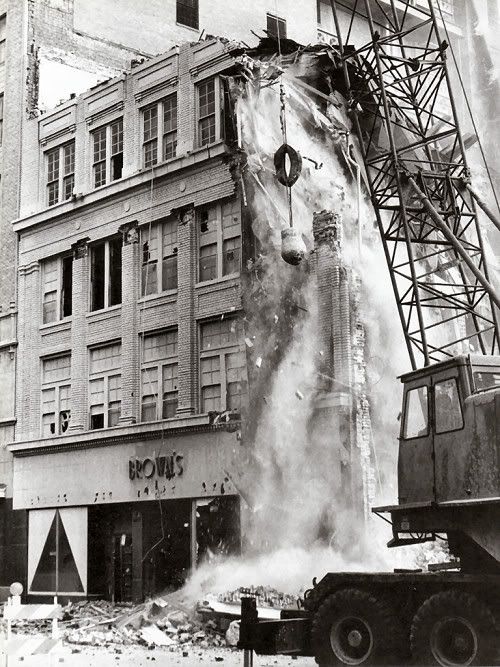
This article does not explore with any detail why that never happened. Steve Lackmeyer & Jack Moneys' OKC: 2nd Time Around does that and on a broader scope than just Brown's. But, at least a couple of points made in their book should be mentioned:
(1) The fault cannot be laid at the doorstep of I.M. Pei. At page 14, the authors noted that:
Pei introduced his ideas first to Urban Renewal commissioners. A retail reorganization was needed, he said, but he cautioned it would have to be done as a "musical chairs" type operation. "We cannot afford to allow one of the close temporarilily while its location is being removed." Pei told commissioners they should consider having a new store built for John A. Brown before tearing down its cramped old location."(2) For whatever reasons, that advice was not followed and by the end of 1977, none of those plans had fallen into place. The pair of articles below gives greater detail than I'll comment upon here, except to say the August 28 article reported on a trip to Dayton Hudson in Minneapolis by a blue-ribbon committee of civic, business and governmental leaders whose mission was to persuade Dayton Hudson to become the anchor tenant in the proposed 1.2 million square foot retail galleria, and the September 9 article merely reflects the difficulty the city was having in securing a developer for the galleria project, per se.
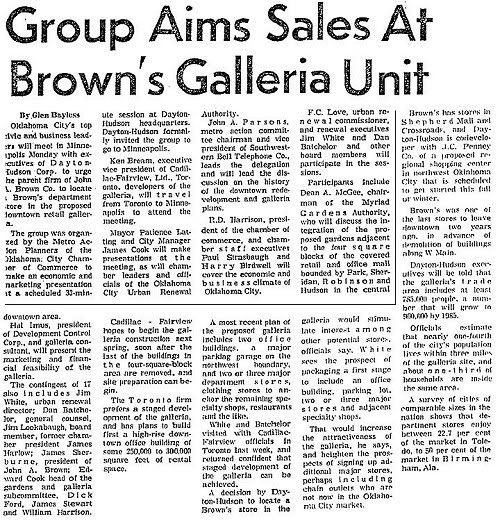
September 9, 1977
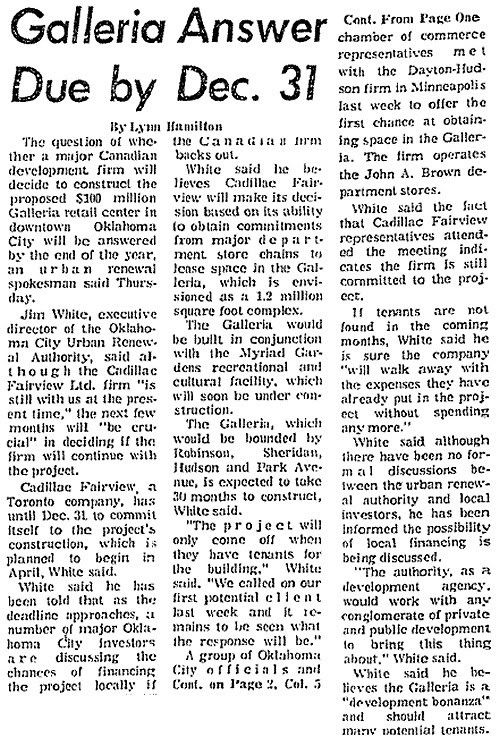
Building demolition and space clearing all occurred before 1980, but, by 1980, no galleria plan had gelled and Dayton Hudson may have given up on being an anchor tenant, I'm not sure. Certainly they had not agreed to become one. In 1980, the former John A. Brown's properties were dust and mud. The pair of images below are from OKC: 2nd Time Around, one edited by me, show the Brown's space in 1980:
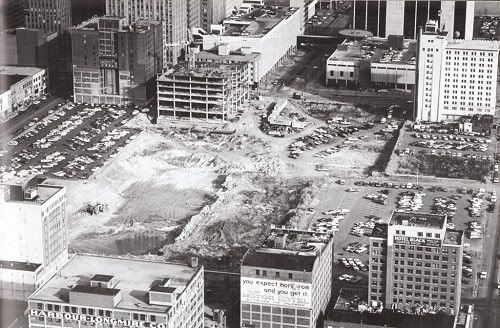
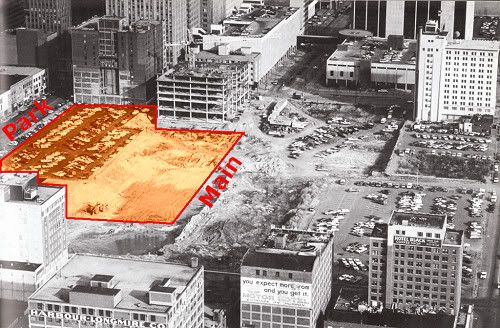
Penn Square Bank failed in 1982 followed by the domino-like effect of bank failures locally and beyond, including but not limited to the mighty 1st National Bank of Oklahoma City. The galleria would not happen. Brown's would not return to downtown.
OTHER BROWN'S STORES. Several other stores and buildings were part of the John A. Brown's portfolio, including a store in the Quail Springs Mall, but I have only this Oklahoman clipping for that:

Photos that I've located for others are shown in this section.
Although I located no transaction in the Oklahoman archives stating when it was acquired, the Brown's Warehouse existed by 1942, at least, when ads of its shrubbery department at 214 W. 2nd began appearing, and another ad shows a 213 W. 1st address. 1950's articles describe a traffic problem created by Brown's trucks loading or unloading from the Couch Drive side.
Warehouse Outlet where Leadership Square sits today, on Couch Drive
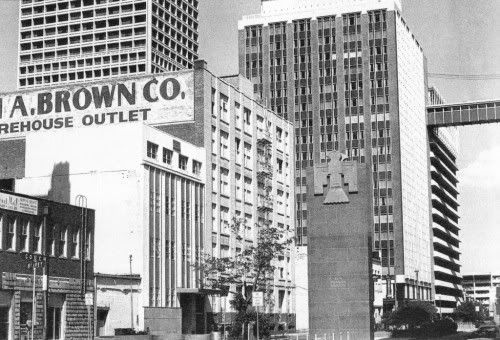
1940s OHS photo of Brown's Warehouse on NW 2nd (RS Kerr)
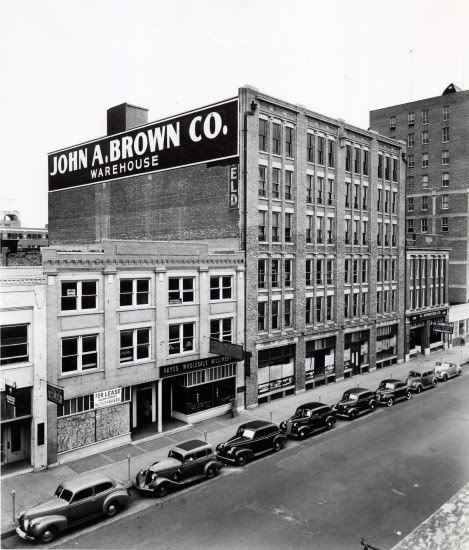
From OHS, a Brown's warehouse at 901 W. Sheridan

For a brief time, November 1948 until 1951-1952 or so, Brown's leased the space of the former Britling Cafeteria at 221 N.W. 1st for an Appliance Store, doubtless ending that operation with its much larger expansion on the south side of the 200 block on West 1st -- and thanks to bornhere at OkcTalk.com for figuring this one out! Britling Cafeteria operated at that location from 1932 until its dishes, furniture, etc., were liquidated without fanfare in August 1948. As seen in the OHS photos below, the property was identical save for the signage change as well as what was offered for sale -- click on the small photos below for larger views:
Britling in 1938 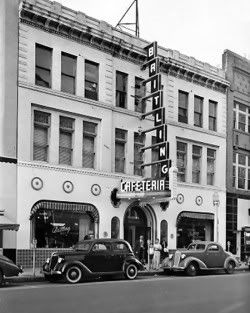 | Brown's in 1951 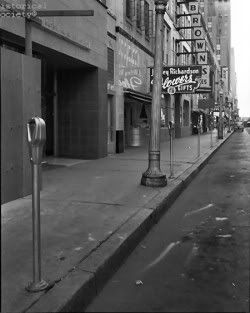 |
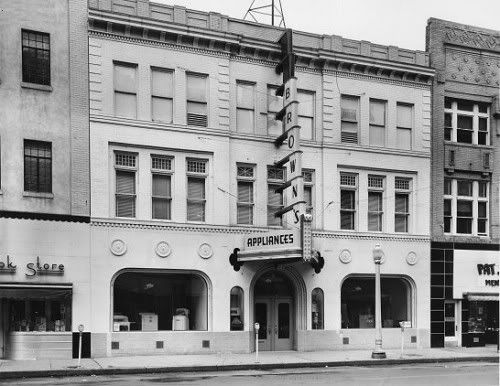
Brown's Capitol Hill store at 319 S.W. 25th/Commerce opened in March 1948 and closed when the downtown store did, in 1974.
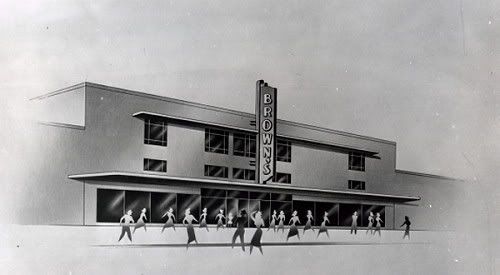
From OHS, Brown's at Capitol Hill in 1956
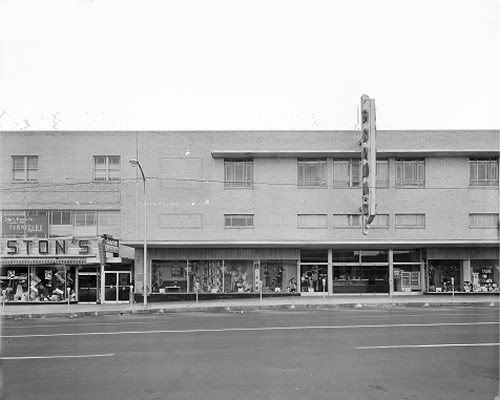
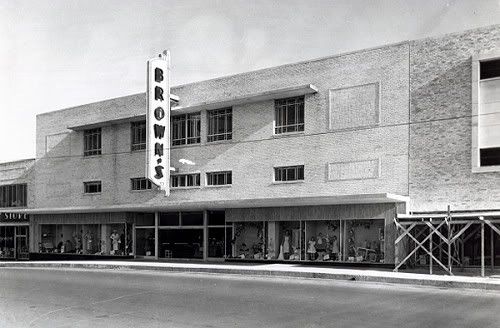
Tire Center a NW 39th & Pennsylvania Avenue
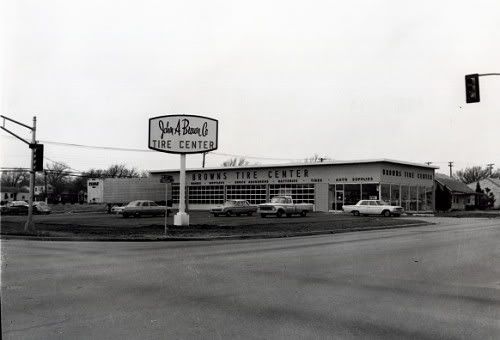
Brown's at Penn Square around 1960
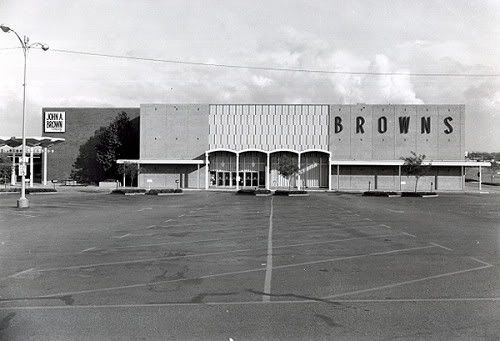
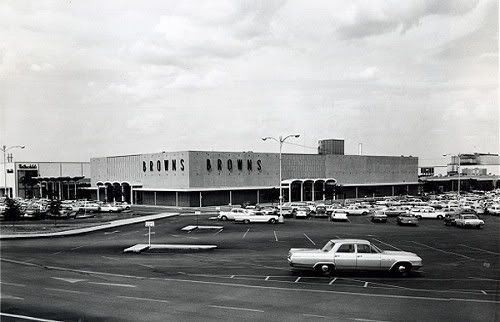
Brown's College Corner store, Norman, late 1940s
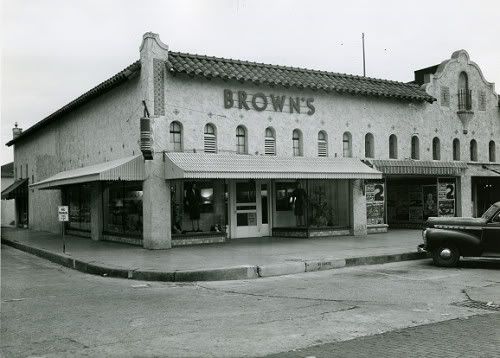
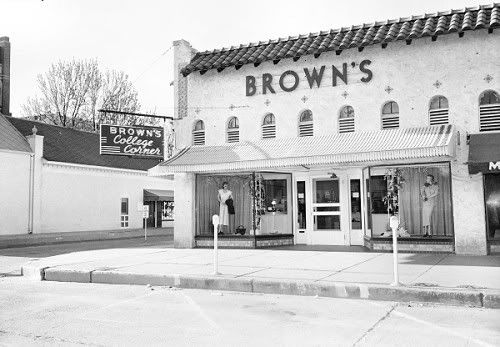
Although separate from John A. Brown's, the Brown & Dunkin family members owned the fine Brown-Dunkin Department Store at 4th & Main, Tulsa. Della Brown's April 25, 1967, obituary says that the family interest in the store was sold in 1960.
Credit Tulsa City County Libraries Beryl Ford Collection


Woodland Hills Shopping Center, Tulsa
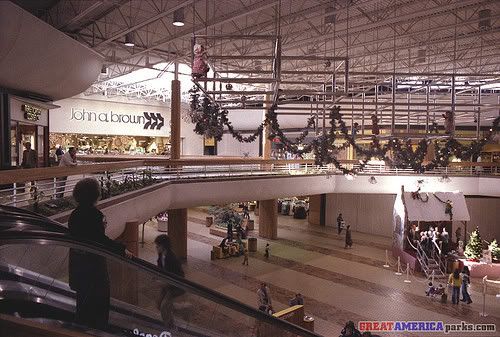
A John A. Brown's also existed at Utica Square, Tulsa, however I have no images of that property.
THE END OF AN ERA. The store's family name, as well as the John A. Brown Company legacy, came to a final end when Dayton Hudson sold the John A. Brown's properties to Dillards Department Stores, Arkansas, in 1984, as shown by the Oklahoman articles below.
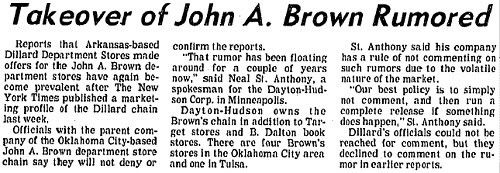
August 9, 1984
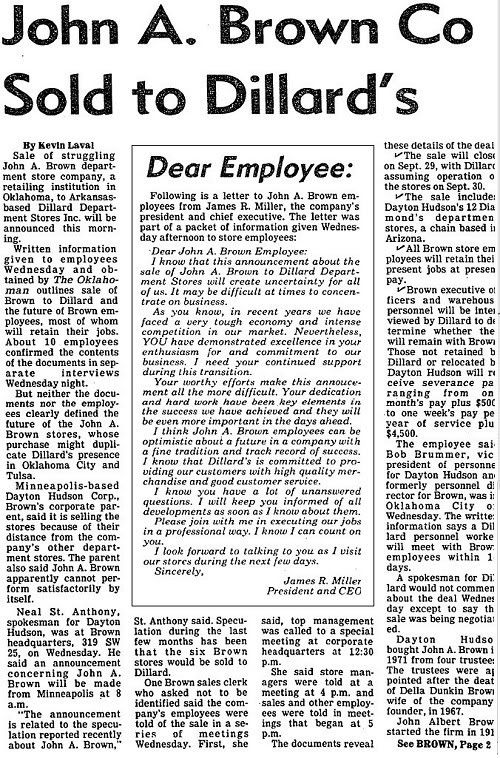
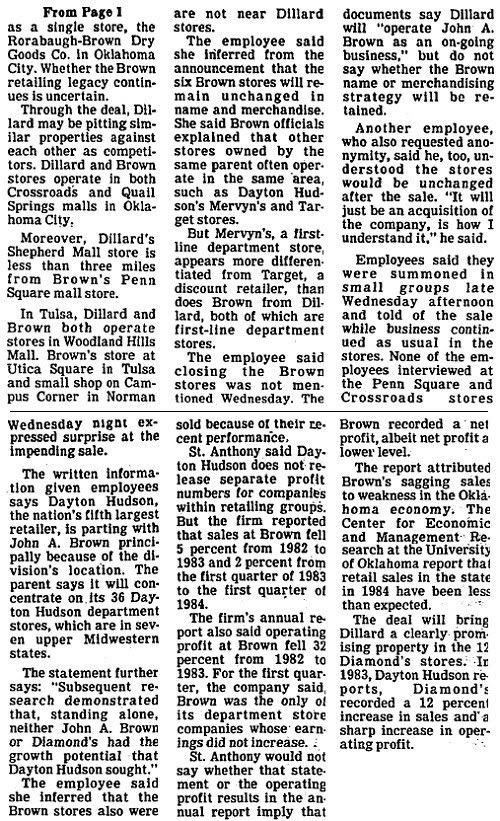
August 10, 1984
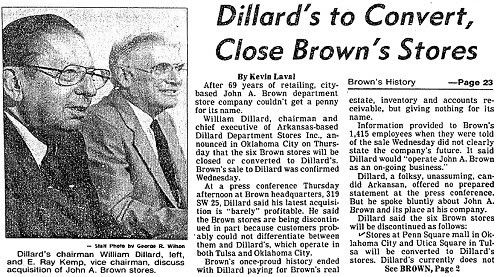
With that, John A. Brown's Department Stores became nothing more than a memory. An August 10, 1984, retrospective on the life of Della Brown, sums it all up:
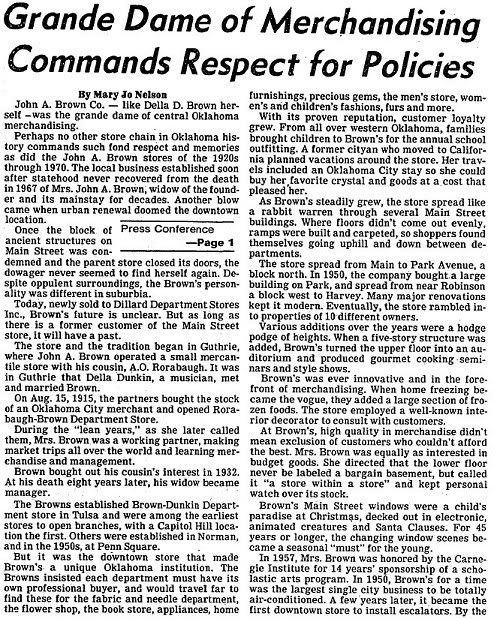

"But one thing is certain: Brown's as it was is gone." Even so, all who are old enough to have been there will have their remembrances and anecdotes. Thirty-four years after Brown's closed downtown, at OkcTalk.com rondvu recently began a thread which was actually the inspiration for this post and its associated research and writing. In that initial post, rondvu said,
I would love to hear stories, jingles and or pictures of the John A Brown department store that was located in Oklahoma City. I have two postcards that were sent by Della Brown from London and Paris trip in 1963. I remember the familiar John A. Brown and Company gift boxes. I also have a bridal book from the store, very interesting indeed.His query sparked the interest of several, me included. Ron was kind enough to share the bridal book -- an amazing 126 page book that Brown's made available to brides-to-be which containing about everything one might need to know (including how and what to do if the wedding was called off). I've scanned a couple of those pages:
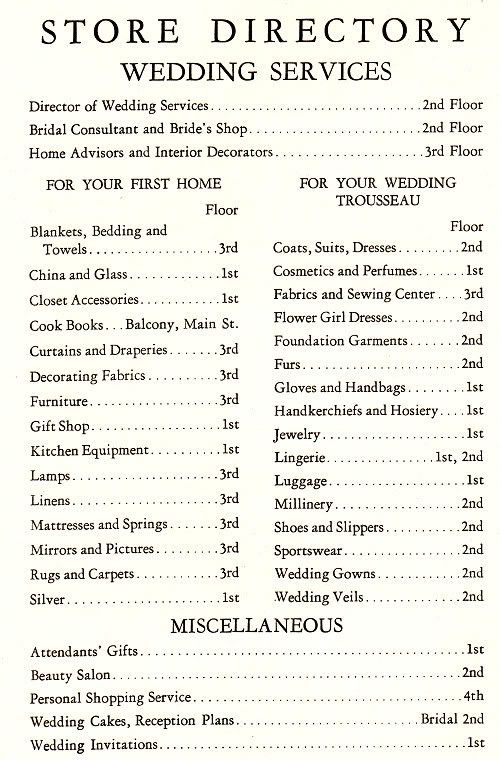
Part of the Introduction -- trousseaus, etc.
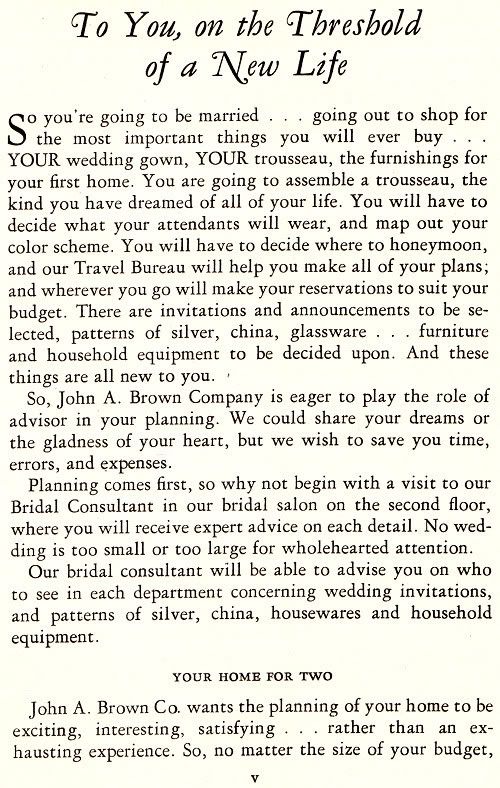
In that same thread, PapaJack (who can always be counted on for great Oklahoma City historical anecdotes) had his recollections. He said,
I don't remember it having an entrance on Main Street. The various buildings were indeed disjointed. I remember having to exit the main building in the alley between Park and Main, and re-entering another building on an escalator which was outside in the alley. I have never seen another escalator on the outside of a building like that.Totally gone.
The Men's department was on the West end at Harvey and Park. It featured a life-size stuffed Tiger. On the right shoulder of the tiger was a little wire hook, that when pulled would emit a loud "roar." Whenever we went to Brown's I had to find the Tiger and my mom would lift me up so I could "moo the tiger." I continued this event until Brown's closed its downtown location. I guess the tiger was quite old (as was all of JAB's fixtures) by then, and I was a grown man. The commotion "mooing the tiger" brought was great fun as JAB's customers and employees were totally unaware of my discovery.
I do remember the pneumatic tubes, and also the little metal "JAB charge card" my mother cherished. JAB issued the metal cards, which looked like military dog tags, with a small leather cover. All of the pertinent data was on raised letters that printed on receipts with carbon paper. Totally mechanical.

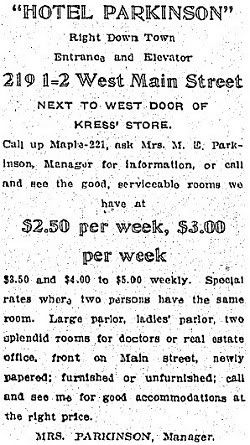














30 comments:
Hello Doug,
There's a lot of history with John A. Brown and you've brought much of it to this post. Another excellent job.
I haven't posted at OKCTalk since August. Trying to discuss economics with some of the far-right posters was just too much. They turn everything so personal and their "Whatever is good for big business is good for America," attitude was so strident. Ironically, since my last post at that forum, we've seen just how "responsible" finance capital is as our economy has gone into meltdown. I saw a chart today that shows how every single bridge in America that needs repair could be repaired for 103 billion dollars. In contrast, in the last 60 days, the U.S. government has handed out 1.8 trillion dollars in five bailout packages; of which the 700 billion was only the largest. I think of some of those people at OKCTalk (and shake my head) as I shudder to think what another 8 years of "conservative" rule could mean for America.
Keep up the good work, Doug. You do an incredible job.
- solitude
Thanks, Solitude.
I think that you're being too hard on OkcTalk.com, though ... there are a number of liberals there, too (like myself, even though I tend to avoid most of the political discussions as being rather pointless). I just had look at its presidential poll ... the top 2 vote getters were McCain (47%, 99 votes) and Obama (46%, 97 votes). Ha! This state is surely going with McCain at a much higher percentage than that, don't you know? After a breather, I hope that you'll again become active there.
Thank you so much for the articles on John A. Brown's!! I have great memories of my mother taking me downtown and to Capitol Hill to shop at Brown's. It was always such a treat. The downtown store was definitely one of a kind and a special part of Oklahoma City history. I miss it!
Thanks, dm. As this comment is written, I'm still working on "finishing" the article and still have a good bit to add -- even though many would probably say that it's too long, already! Come back in a day or two and it will hopefully be done.
I have just discovered your articles on Brown's and am really enjoying it. I have something to contribute. Entering the Main Street entrance and walking toward the back of the store, on your right was an escalator that took you up to the mezzanine where all the uniforms, badges,etc. for the Boy Scouts and Cub Scouts were located. It was also the local headquaters for the Superman-Tim Club where they gave out free Superman-Tim comic books,colorfull stamps and other neat things. While free at the time they certainly aren't now. Ebay prices start at around $30 and go up. Does anyone known of a cornor in an old warehouse where Brown's may have stored a stack of these comics? Dream on dreamer. Bob of OKC
Hi Doug:
I was trying to find information on the old Split-T restaurant (owned by Vince Edwards) when I came across your blog.
I grew up in OKC and my great-grandfather worked at the downtown Brown's in the china department for like thirty years. My great-aunt also worked at the downtown Brown's in the children's shoe department. So, I spent half of my childhood in the downtown store.
My father's parents had a cleaners & hatters on 6th & Robinson that cratered when the OKC bombings of the federal building occurred.
I can't begin to tell you what a lovely tumble back through time you have provided me with. I literally grew up on the streets of downtown OKC, although if my mother had known, some heads would have rolled. However, I was a bit of a wild child & ran off to visit people I knew all along the way to Brown's, where I'd go to see my other relatives. Most of the employees at Brown's got used to me appearing out of the blue & they knew who I belonged to. Also, my mother worked for a few years in the Cravens Building, for an oil company. For a treat, we'd go eat lunch at Anna Maude's Cafeteria, for which I'd give my right eye to eat there again.
I have no doubts that under hypnosis, I could tell you a lot more about Brown's & the downtown area. Unfortunately, time has taken it's toll on my poor brain, so I probably couldn't remember it all otherwise.
I also attended a Catholic school downtown (almost) called Villa Theresa, which I have very fond memories of. Later, I also attended John Marshall and Putnam City high schools, before we eventually moved to Aspen, Colorado. I've now lived in Texas for 35 years.
I'd love to contribute whatever I can to your writings about OKC. So far, you've done an outstanding job & I've loved reading all about it.
Hey, Snooty! I see that you now live in Midland ... one of my brothers lives in Odessa. What a GREAT comment! If you'd like to write a guest article or something else, send me an e-mail ... click on the Doug Dawg link, above, and you'll see how to do that.
I intend to do a Villa Teresa article but I've just not gotten around to it. Maybe writing about that would interest you.
Thanks again for the great comment.
Thanks for a fabulous walk down memory lane. My first job in 1972 was at John A. Brown's in the downtown store. Spent a week in training and then another week on the floor with a sales manager observing before I was allowed to serve customers. And unlike today, I had to know my merchandise, was closely supervised and expected to treat everyone as if they were royalty. At Brown's no question asked-the customer was always right. I remember one time a very elderly lady brought back a horrendous girdle, still in the package, that was yellowed with age -- had to be 15 years old. We returned her money in full, with a smile. If you wanted quality you went to Browns. If you wanted something that would last you went to Browns. And they had everything -- from dinettes to tires to lingere. But best of all -- you could get lost for days in the store. I worked through high school and college -- and after it was bought by Dayton Hudson it was never the same. Mrs. Brown knew how retail, knew quality and knew how to run a tight ship. How I wish she and her store were here today. Thanks again for such a wonderful trip down memory lane.
Thanks, anon. Great comments!
Someone recently told me that Browns had a shop on NW 23rd east of the Tower Theater at some point (at least as of 1959, he said) but I've found nothing about that.
Do you or anyone else know anything about that?
No, sorry, I am not sure about the NW 23rd store...I'll ask my mother but with her failing memory not sure she will remember. BTW, another point about JAB, they didn't have sales every week, red apples or such, but when they had a sale, my oh my was it a sale. And the bargain basement downtown always had wonderful goodies. When they shut down the downtown store my mother bought sheets and towels for pennies on the dollar. One particular set of twin Oleg Cassini sheet sets for twin beds are STILL being used in her guest room --haven't lost one bit of color and the elastic around the bottom sheet is still as tight as the day she bought them. That's the type of quality you found at Browns.
My husbands grandmother worked at the John A. Brown store downtown OKC for years and years. Do you have any pictures of the employees of the John A. Brown store downtown. I have one that I have acquired but its not very good quality. Its of the ladies standing around the perfume counter. If you want it, I'll send to you. Thanks, Melinda Pennington
Thanks, Melinda,
I'm pretty sure that most everything I have is in the above post. If the photo you have is good enough to make out the features of the people well, sure, I'd be glad to have it.
Hello
I am not from OKC but I recently came across 3 picture frames one is the Congrefs of the United States, We The People, and Declaration of the thirteen United States of America 1776 that were framed for John A.Brown dated 1965 and just wanted to research on who this person was. I guess I found a treasure.
Anon, yes, you have what many who live here would consider a real treasure.
Hi Doug, I am trying to trace what happened to the John A. Brown locations after Dillard's purchased the company. Trying to piece bits and pieces together, did the Crossroads, Quail Springs and Penn Square JAB's become Sanger-Harris? I am almost certain that about Crossroads and Quail Springs, but Penn Square I cannot determine - thank you!
Thanks for any guidance you can provide.
Steve,
If any of the Brown's stores ever became Sanger-Harris, I'm either not aware of or have forgotten such a thing, but I'm pretty sure that never happened. The lineage of Browns, post-Della Dunkin Brown's death, is: Dayton Hudson of Minneapolis acquired the stores in 1971, although the trade name of Browns was retained during that company's ownership; then in 1984 Dillards acquired the former Browns stores and they became Dillards in all former Browns locations that then existed, in name and in fact. See the August 10, 1984, Oklahoman article, above.
Anyway, that's the best that I can do, and I hope this helps.
Regarding Sanger-Harris, note the Dillard comment in the 8/10/1984 article where he only says that the Penn Square and Utica Square stores would be converted. I worked at Dil-mart briefly as a Christmas hire in 1987 and have a fair recollection of the department stores from that era. If memory serves, Dillard wasn't interested in the extra space at X-roads or Quail (or mall leasing restrictions possibly prohibited expansion to two anchors by one tenant), so they dumped those former Brown locations and sold the buildings or leases to May or Federated, whichever was parent of Sanger-Harris at the time. It was a busy period for retail mergers. So, S-H just had the two stores in OKC (X-roads and Quail Spgs) because Dillard's didn't already have a location at Penn Square to unload. Just a couple of years later, Sanger-Harris was converted to Foley's under Federated. That's around the time that they built their new store at the north end of Penn Square, which I'm fairly positive started as a Foley's and was never a Sanger-Harris like the Foley's stores at X-roads and Quail had been. Dillard's nonetheless wound up having the two stores at Penn when they took over the Rothschild's space.
As an example of don't-believe-everything-in-the-paper," there is an inaccuracy in the 8/27/1977 article stating that "Brown's has stores in Shepherd Mall and Crossroads..." After the passing of a few decades I wouldn't swear to anything but I'm pretty sure Brown's never had a Shepherd Mall store. Shepherd Mall opened in 1964 and I doubt Brown's would have wanted to compete with a location so close to their own other stores downtown and at Penn Square (1960).
How did I land on this particular blog post in the first place? It's fascinating even though I hate to shop!
Word verification: stoli
Best regards,
Digger
I remember going down to Browns to use my grandmother's charge card to buy underwear or a shirt so that I could get the free gift. They never asked for ID back the day. Another indicator is an early mall directory that states it as "Dillards Brown-Duncan." We were raised at that mall as our grandparents let us hang out on weekends to keep from getting into trouble. They would drop us off on Saturday noon and we would stay until we met at Furrs to eat in the evening. I remember the county deputies on horseback during the Christmas rush. I also remember the Christmas train. The Shepherd Twin had a light bulb marquee that was unique. We almost never exited the main entrance and always went out the back doors. I remember the Gold Mine game room, Orange Julius, El Charito, the old postal vending stand in the west parking lot, and the unique atmosphere not present in today's malls.
I come from a long line of Wichitans, but beginning sometime in the mid-1950s my maternal grandfather went to work at Tinker Air Force Base, which meant that my parents and I made weekend visits to Oklahoma City. I suppose I've always been interested in department stores, and my first memory of my grandparents in Oklahoma City (I was perhaps seven or eight years old)was on a Saturday afternoon, in the basement of the John A. Brown Co., seeing my grandmother working behind a lunch counter. I further remember that Brown's, as you've written, was a series of old buildings with uneven floors. I also remember being in Brown's men's store on Park Avenue.
My grandparents lived on Capital Hill at 511 SW 24th St., and I remember the Brown store there, though I don't remember being in it. My grandfather eventually purchased a duplex at 2613 NW 12th St. From that address, I remember the new Brown store in Penn Square. And I remember being in Halliburton's, on a Saturday afternoon in 1960, the last day the store was open. I also remember when Shepherd's Mall opened with Kerr's department store, which soon became Dillard's Brown-Dunkin. I remember my grandfather saying that Kerr's motto was something similar to "If it's for her, it's from Kerr's." I remember driving by Kerr's on Main Street, but I don't believe I was ever in the store.
What interests me about Brown's is that A.O. Rorabaugh, who, as you write, founded the store with John A. Brown, had stores at one time or another in the Kansas cities of Emporia, Newton, Hutchinson, and Wichita. In Hutchinson he had a partner named Wiley and that store, originally called Rorabaugh-Wiley, was taken over by the parter and called Wiley's, similar, of course, to what happened in Oklahoma City.
In Wichita, Rorabaugh in 1903 purchased Cash Henderson's Dry Goods Co. His partner in Wichita was named Buck, and while three generations of Bucks would be involved with the store, the store was called Rorabaugh's until after Rorabaugh's death in 1936. For a few years it was then called Rorabaugh-Buck, and then, beginning in 1943, until it closed in 1967, it was called Buck's.
The ads you show for Rorabaugh-Brown look exactly like the ads in the Wichita newspapers for Rorabaugh's. Could the advertising for both stores been created in Wichita?
It also interests me that in both Wichita and Oklahoma City, the two stores never built new buildings, as their competitors did, but rather expanded into older buildings. In Wichita, the Geo. Innes Co. in 1907, built a new, six-story building. Rorabaugh's, which was located next to the old Innes building, expanded into that building, as well as another neighboring building. Photos of Rorabaugh's at that time - three, three-story buidlings on North Main Street in Wichita - look very similar to Rorabaugh-Brown's on Main Street in Oklahoma City!
In 1927 Innes again built a new store, more than twice as large as the 1907 store. What did Rorabaugh do? He announced that he was going to build a new store, then that he wasn't. In the meantime, the 1907 Innes store had been taken over by Sanger Brothers of Dallas, and in 1934, probably because of the Great Depression, Sanger's sold out to Rorabaugh's, and Rorabaugh moved into the old Innes building, where it was to remain until it closed.
Unlike in Oklahoma City, where it was the leading department store, Rorabaugh's was the number two store in Wichita. In 1948, Innes' would add an eight-story building to its 1927 building, giving it a total of 296,000 square feet of floor space. Rorabaugh's, now Buck's, would continue on in the 75,000 square foot building that Innes had left in 1907.
C.W. Sloan, Jr., what a fascinating and interesting comment. In many ways, Oklahoma City and Wichita have had a historical connection, though I didn't realize this one until your comment.
Would you be interested in elaborating your words (and others) into a guest article? Of course, the credit would be yours. E-mail me if you are interested ... click my icon and you should see an e-mail link or something that will get you there.
as a very young child in 1963 i enjoyed the executive dining room at christmas. della was at the head of the table w/ several buttons to call for service(she let me play w/ them and told people to return to thier duties). i must have been about about 7 yrs old she told us to go and enjoy the toy department!! i remember running and jumping to get there. we were quickly pulled away from it all. there were 4 of us. we received at least 2 pkgs. apiece for 4 or five christmases. my father Donald M. Brown grew up in Canton, Oh. his father Henry Aron Brown was John A. Brown's brother
For the Christmas season of 1965, I obtained seasonal work at John A. Brown's downtown store. I had graduated the previous spring and had worked in a construction materials supply office as I had done during the warm construction season every year. Since I did not have enough money to go to college that fall, I was glad of the seasonal work. Although Brown's put me through sales training, they discovered that I had office experience so they sent me to the Credit Department. My office experience caused them to hire me as a permanent full-time employee after Christmas. I remember one little old lady wearing a corsage one day because she had been honored for having worked there for 20 years. That strengthened my resolve to save every penny I could for college. In order to enter OCU as a full-time freshman student, I quit John A. Brown's in January 1967. If I understand your article correctly, that was 3 months before Mrs. Brown died! It appears that my guardian angel was working overtime even back then! Thank you for making me aware of that time line.
Thanks, Mary. I am a true believer in Guardian Angels -- if I didn't have my own, as my grandmother would say, I'd be a "blowed up sucker." I've never figured out exactly what that means, but I get the drift. As far as time-line, I figure that I get their help all the time, even when I'm bad. I'd suppose that to be true for you, as well -- the "all the time" part ... I didn't mean to imply that you were/are/will be ever bad.
I took no offense. I am so thankful for this page. Thank you for hosting it. It reminds me how far I have come.
I remember the lending library on the mezzanine (opposite the Main Street front door of Brown's). People actually paid money to borrow books. I have a vague memory that there was a tiny staircase from that library up to another floor, but it's too long ago. That store was such a rabbit warren of staircases and ramps.
The photo at the top of this page holds so many memories, including that of the Forum Cafeteria. I stopped eating there when some of the other office workers took me to a thrifty eating place in the basement of an office building.
I note that C.W. Sloan, Jr. mentioned the closing of Halliburton's Department Store. My mother went into mourning when Halliburton's closed. She was slightly mollified a few years later when I went to work at Brown's because she could arrange to meet me on our mutual lunch hours so that she could use my employee discount!
This page pulls out so many hidden memories that I had forgotten. Thanks, again!
Doug, words cannot describe how grateful I am for this article. My grandfather was John's nephew and he and my grandmother were buyers for the store. My dad grew up around the store and loves gathering history about it so I've shared this article with him. If you would be interested, I'm sure he'd love to talk to you to fill in any gaps. You can get in touch with me at christen.c.brown @ gmail.com.Thank you for writing this!
Thanks, Christen. I'll be indisposed for a couple of weeks and I'll get back by email after that.
Doug,
thanks for the photos and memories. My grandfather Eliot Lyon started with Mr Brown in 1902 and retired in 1962. 60 years as John A. and DD's VP. In the late 40's my dad was the buyer of lady's ready-to-wear and then in '56 he bought the Anna Maude, I became a co owner in 83 and ran it until we closed it in '88. Many great memories and stories (too many to publish) growing up downtown with John A Brown, the Anna Maude and my first job delivering "The Downtowner" newspapers. Great to see downtown OKC coming back. My dad, Cooper Lyon never wanted to move the Anna Maude from downtown, unfortunately as you know the Galleria never came together and downtown went into hibernation for 30 some odd years. I know he would be elated for its comeback. Thanks again for the memories. -Charlie Lyon
Sidney L. Brock was my great great grandfather. After selling his store he remained virtually retired the rest of his life until he died in 1943. Still have some relics of his passed down from his time in OKC. Thanks for the post--enjoyed the read.
I am not sure if this has been addressed but I think I may have figured out why some people think there was a JAB's at Shepherd Mall. At the north end of the mall, there was a Dillard's store. I can't remember what was there before, maybe someone else can. The Dillard's store existed at the same time as JAB and perhaps some people think that since JAB eventually became Dillard's, it must've been a JAB's before. To my recollection, there was never a Brown's store there. I hope that helps some to make sense of this mystery.
Also, Doug, thank you for referencing my elder cousin, Willis Baker, in your blog. He came from a long line of journalists and columnists. It was so good to be reminded of his place in the history of OKC.
My grandfather Kermit Jarrett Hardwick, served as General Manager of John A. Brown's from the 1930's until Dayton Hudson acquired them in the 1970's....I could tell lots of stories and my mother could really tell some! Also, if anyone remembers him, I'd love to hear anything remembered. He was a kind and gentle man, but as an employer I can imagine he was fair and reasonable, but probably the type that would stand at the clock and write you up if you were 20 seconds late. He lived by a code of honesty and integrity, and in my time with him, I don't think he really ever understood that anyone else might not live with those same principles.
Anyway, I'd love to help fill some stories, and I'd love to hear some too!
Post a Comment